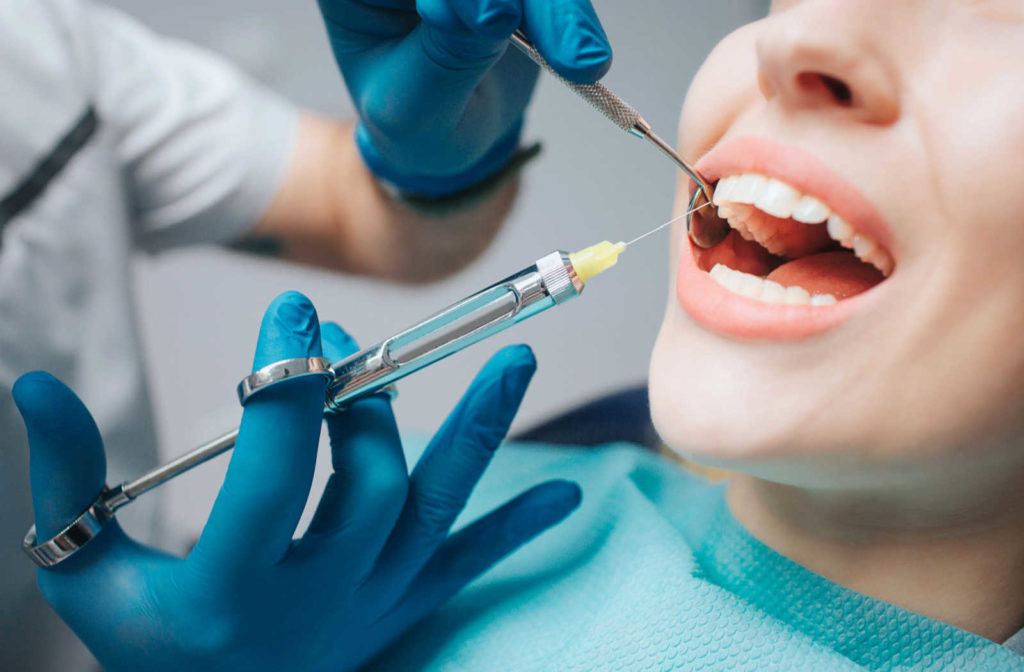Tips for Unfreezing Your Mouth
Numbing or freezing is common with many dental procedures, from simple fillings to root canals. Avoiding the temporary discomfort can be a relief during a procedure, but numbness can be a nuisance after your appointment.
Localized freezing can affect more than your tooth, spreading to surrounding tissue. It can be an odd sensation and may make it more difficult to speak clearly. Additionally, general anesthesia used in oral surgery can cause a pins and needles sensation.
So how can you speed up your recovery and unfreeze your mouth?
What Is Dental Anesthesia?
Dental anesthesia is commonly used for many types of procedures. Local anesthetics temporarily numb an area to improve patient comfort. Usually, local anesthesia takes effect within 10 minutes and can last about 30-60 minutes.
General anesthesia is sometimes used during oral surgery, including wisdom tooth removal. After the procedure, patients can experience numbness or pins and needles. In most cases, the sensation will fade within hours after surgery.
The side effects of dental anesthesia depend on the type of anesthetic used and a patient’s reaction. For example, you may tolerate numbness better or find numbness goes away more quickly. But when numbness or pins and needles seem to last longer, it’s handy to have a few tips.
Massage
Massaging your lips, jaw, or tissue outside your mouth can stimulate blood flow. However, it can sometimes feel odd when the skin you’re touching is numb, so remember to massage gently.
Before beginning your massage, check the area for any swelling or pain. The goal is to warm up your skin without injuring yourself. Applying repeated pressure to a tender may cause increased discomfort when the numbing goes away.
Avoid touching the anesthesia injection site or treatment area directly. Instead, focus on areas where the numbness may have spread. For example, suppose you have a filling in an incisor (front tooth). Then, you might gently massage a couple of teeth back (around the premolars).
Massage outside the mouth rather than your gums. Wash your hands before and after massaging your lips, mouth, and face.

Get Active
Movement is another way to stimulate blood flow and flush the numbness away. Depending on the type of dental procedure, you may benefit from a brisk walk or strenuous household chores.
Ask your dentist if it’s safe to engage in rigorous activity after your procedure. Recovery for some procedures may benefit more from relaxing than exercising. Stretching can also improve circulation and give you an activity to focus on while the numbness wears off.
Warm Compress
The opposite of freezing is heating, so why not use a warm compress? Applying heat to the skin increases blood circulation and can improve healing. Place a moist, warm compress on the affected area for up to 20 minutes.
Be careful of the temperature. The compress should be warm but comfortable. You may wrap the compress to avoid touching the skin directly. Also, check for swelling first. Some inflammation is normal after a procedure; however, heat causes blood vessels to dilate, increasing swelling.
Applying a warm compress is generally safe and effective for minor dental work, such as a filling or crown. However, your dentist will provide instructions for more invasive procedures, such as dental implants or a root canal. Applying ice or heat as directed can control inflammation and promote healing.
Hydrate
After most dental procedures, your dentist will likely ask you to avoid eating or drinking for an hour or more. So it’s crucial to follow your dentist’s instructions. How long you have to wait depends on the type of dental work.
For example, a composite filling will harden immediately (thanks to the dentist’s special blue light). Still, you could accidentally bite your cheek or tongue while eating because of the numbing. After oral surgery, your mouth may need more time to heal before you can swallow or chew comfortably and safely.
However, drinking water is usually okay soon after most dental procedures. It’s still crucial to get your dentist’s approval first. Drinking fluids can help flush the anesthesia and support healing. Avoid warm liquids (such as tea) and stick to sugar-free fluids for the first few hours.
Suction
Making numbness go away after the dentist is all about encouraging circulation. Sucking on ice chips or hard candy can also stimulate circulation. The action gets your lips and cheeks moving, like a workout for your mouth.
However, sucking on a straw or candy can cause complications after more invasive surgeries, such as a tooth extraction. The suction can dislodge a blood clot leading to dry socket. Check with your dentist or oral surgeon before trying suction to make numbness go away.
Contact Us for More Tips
After a dental procedure, don’t hesitate to contact us if you have questions! Talk to your dentist when numbness is overstaying its welcome or you want to resume normal activities safely. We’re here to support your oral health and comfort.Book an appointment with Shawnessy Dental today!


